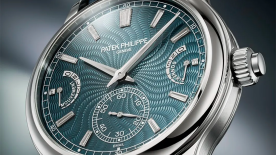To reveal the magic of a watch’s mechanics today, it is no longer enough to simply skeletonize a movement to let in the light. One needs to establish a clear vision of the stylistic identity of the manufacture and its interpretation of the art of watchmaking.
This identity is a continuation of that implemented by Jean-François Bautte, the watchmaker whose company, launched in 1791, would give rise to the Girard- Perregaux Manufacture. From this point of view, the time becomes a pretext for revealing the potential of the mechanical watch as a work of art.
Delicate and complex, the openworked structure of the large 1966 watch movement with automatic winding, measuring 13¼ lignes (30.00 mm), invites contemplation of its bridges and plates. Gears, levers, bolts and other usually invisible components can be glimpsed within the openings – chamfered, polished, satin-brushed and hand-finished by the watch artisans. The leaf-shaped hands along with the balance wheel placed at 12 o’clock create the defining graphic feature of this watch, featuring a 38mm 18K pink gold case.

Derived from the GP1800 caliber, the movement - comprising 173 components, including 25 jewels - is treated using a galvanic process (anthracite gray ruthenium) and worked like a metal net. The regulating organ features a “Microvar” variable inertia balance exclusive to Girard- Perregaux, pulsating at 4 Hz (28,800 vibrations per hour).
The skeletonized oscillating weight, visible through the sapphire crystal case back, has been crafted in gold. It ensures optimal winding of the barrel destined to guarantee autonomy of more than 54 hours.
The 1966 Skeleton watch is worn on a black alligator strap fastened by a pink gold pin buckle.





